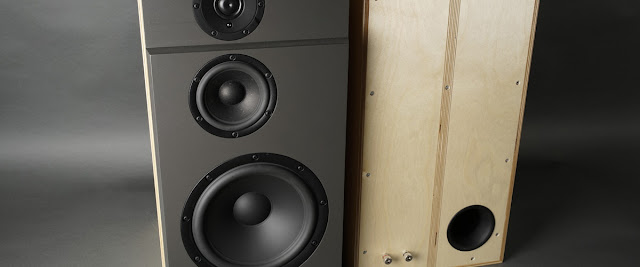The 3-Way Classic Part 1.
I have been planning to build a pair of 3-way speakers for our living room. The room is quite big in the middle of a house with an open floor plan. We seldom listening loud in this room but the speakers are sometimes used with a projector on a big screen. I want my speakers big in exotic veneer but my wife want something small that blends well with our white walls. Mission impossible or what?
I know 8-inch woofers is a minimum for music at moderate levels in this room. I also know that sub-woofers are needed, not for music but when used with the projector. I had a couple of 8-inch SB Acoustics SB23NRXS45-8 that I had used for another build and Troels Gravesen has made a version of his 3-way classics with these woofers. Troels has drawings of the cabinet on his page, response curves and crossover design but without component values (due to douche bags, previously when he posted values, selling kits without Troels consent). It is doable to use software like VituixCAD to reverse engineer the values but you can not be 100% sure to get it right and I also find the passive filters ending up quite expensive. I would like to use the cabinets and my pair of SB23NRXS45-8 but not the way Troels made his SB Acoustics 3WC. I want to use a combination of active XO between the woofer and mid and passive XO between mid and tweeter. I would also like to use a sub-woofer instead of the speaker stand.
With these design goals in mind I envisioned something like in the picture below. The dimensions of Troels SB Acoustics 3WC are 30x30x60 cm and they are supposed to be sitting on 40 cm stands. I thought I could make the cabinets with a plinth (left) that would fit recessed on top of a pair of down firing sub-woofers (middle). The speakers could then be used by itself standing directly on the plinth or in combination with the sub-woofer acting as a stand (right).
That was the general idea but what about additional drivers and XO? I am sure Troels knows what he is doing and that his SB Acoustics 3WC is a great speaker. But the 1-inch SB29RDC-C000-4 is quite sensitive compared to the 23NRXS-45-8 and maybe better suited to be crossed against a 6.5-inch woofer than a 4-inch mid? A 3/4-inch tweeter might be enough. The SB12MNRX25-4 is a great mid but it is 4 Ohms and I was planning to drive my speakers with a 4-channel Tripath power-amp optimized for 8 Ohms. Using an active filter between woofer and mid also makes it possible to compensate for the baffle step loss actively so maybe I could get away with less sensitive elements and a simpler and less expensive passive XO?
A lot of maybes so I started to play around with different elements from SB Acoustics in VituixCAD. To make a long story short,
An ERROR in my simulation led to the wrong assumption that the SB12NRX25-8 would be a good match as a mid. This is wrong, read about the background and solution in my blog post: The 3-Way Classic Part 4.
I then went on with the Enclosure tool to simulate the box impact on the response curves from the datasheets. I did this for the 23NRXS-45-8 in it's ported box according to the alignment used by Troels, and for the SB12NRX25-8 using a 2.21 liter closed box. I then exported Total SPL and Impedance from the Enclosure tool as in the example below.
Next stop was the Diffraction tool where I used the Total SPL from Enclosure tool (for the 23NRXS-45-8 and SB12NRX25-8) and the traced datasheets response for the SB21RDC-C000-4 to generate simulated baffle diffraction and full space response curves for all drivers (using the full space and directivity checkbox options) as in the example below.
I finally loaded the data from the Diffraction tool into VituixCAD as in the examples below (use the feed speaker checkbox option to make it quick and easy).
There is an ERROR in the simulation below. Read about the background and solution in my blog post: The 3-Way Classic Part 4.
Next step was to create a draft XO and fiddle around with component values in order to verify that I would be able to meet my design goals with this enclosure and the selected set of drivers. What I ended up with are in the pictures above. The baffle step loss of around 4 dB will be made up for by room gain and an active XO with variable baffle step correction.
Note that thus far everything is based on simulated data traced from the manufacturers datasheets. The half space response curves was traced and captured using the the SPL Trace tool. The impact from the box was then simulated with the Enclosure tool. The impact from baffle diffraction was then simulated with the Diffraction tool and it was also used to simulate and generate directivity and full space response curves for all elements. This data was finally used in VituixCAD to design a first draft XO. Next step is to build the enclosures and replace the simulated data with real measurements in order to finalize the XO design.
This marks the end of this first post about my 3-Way Classics.











